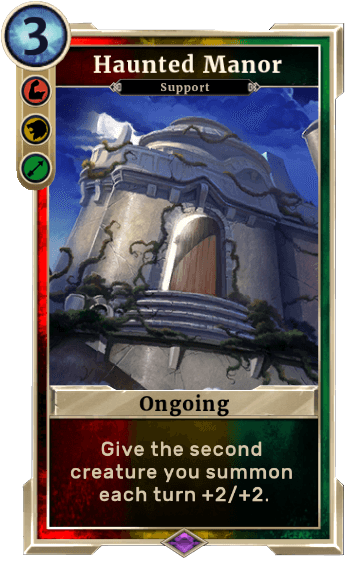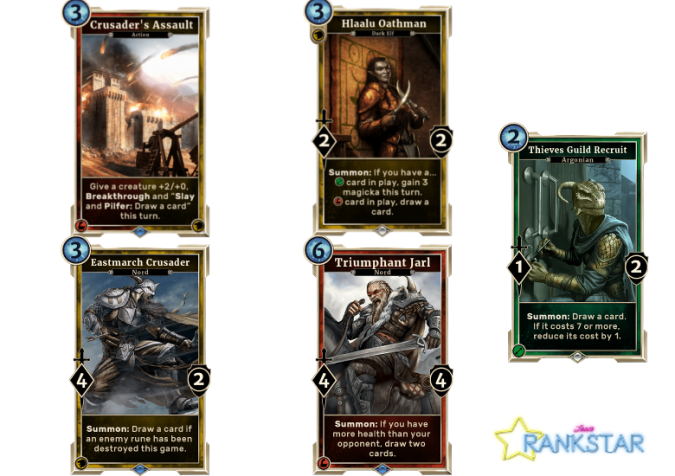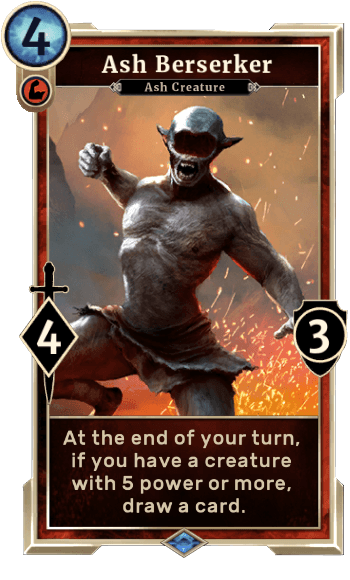Houses of Morrowind is one month old! The meta, while far from established, is starting to settle down. Recently, Warrior7 and Karakondzhul released their meta list with no surprises in the tier 1 section:
In this article, we are going to analyze the core cards, general strategy, and possible variations of Token Hlaalu in the metagame.
Overview
HlaaIu is perhaps the most difficult house to theorycraft. With strong midrange colors, access to mechanics like pilfer, lane moving, drain, and the control package yellow offers, it can be hard to choose which way to go. Hlaalu Token is more than just the traditional token we used to see during the first months of Heroes of Skyrim last year with the imperial dudes getting buffed during the whole match.
The first time I encountered Hlaalu decks, some people tried to put the yellow token core with some of the best red and green cards, resulting in a 75 ‘classic’ token deck. Unfortunately, the consistency of activating a Resolute Ally decreases with the deck size, leading to no triggers from the card and just a tempo loss. However, players saw one card that, at first glance, had the community divided:

There were just two thoughts about this card:
- It’s just a huge tempo loss in a tempo oriented deck (both in aggro and midrange strategies).
- It’s still a huge tempo loss, but you can profit from it later in the match.
I held the first opinion, but how wrong I was. Haunted Manor is a tempo loss if played on curve, but the value you get by buffing your creatures is huge. HUGE. After playing some of the popular lists, I finally changed my mind about this card and started to see how wrong some judgments can be. The card has an elegant design: the 3 magicka cost makes you lose tempo, but the +2/+2 buff makes trading really comfortable and enables an incredible damage burst from your hand.
To gain full value of the card you need to play 2 creatures each turn, thus it’s appropriate to consider low value creatures with powerful effects. Here comes the tricky part: you need to manage your resources. Low cost creatures means that you will get out of cards quickly, so you need a proper draw engine to keep your hand advantage. Fortunately, Hlaalu has the best aggressive draw tools of all the game.

Note the crusader presence in Hlaalu’s draw engine.
Hlaalu Oathman deserves a special mention. Between the five different cards that share the mechanic, Hlaalu Oathman is perhaps the most useful one because: 1) she contributes by drawing a card, 2) 0 mana if played correctly plus a free body to fight for the board and, 3) free trigger for both plot and Haunted Manor. MVP of the deck.
Ash Berserker is the new addition to the deck. Powerful if it gets buffed by our supports or by cards like Fifth Legion Trainer, the card is draw beast that self triggers each turn.

With the draw engine covered, the next step is perhaps the most difficult to attain, that is, managing your resources. Many of my viewers are disgusted of how popular Hlaalu has become. With some practice, and a tournament won with this deck, I can tell you the deck is not just going face every match. Every turn you need to choose which and how many cards you are going to play so that you can: 1) activate the Haunted Manor’s effect with the best creature, and 2) reserve some cards for the next turn, considering what’s left in the board. That’s why I dare to think that this deck is aligned to a midrange strategy with ‘tokens’, or tempo tokens.
Game Strategy
Mulligan
For the mulligan phase, you need to choose between an aggressive start capable of pushing enough damage by turn 6-7, or a tempo start to gain board control. I don’t like to keep Nord Firebrands unless I have Suran Pawnbroker to help trigger the plot effect. Crusader’s Assault is another card that can cause trouble. If you choose to keep it, you expose yourself to use it as curve play on (possibly) your single creature and gain hand advantage in exchange of getting behind in the board. If not, you sacrifice draw power for board control. The right answer? It’s up to your playstyle.
Always keep Haunted Manor in your opening hand if you have low cost creatures so you can start fighting for the board. Usually, a turn 3 Haunted Manor is just what you need to win the game. Your creatures are going to get powerful since turn 4! Keep that in mind.
Finally, keep cards that cost more than 4 magicka out of your hand, unless you predict special cases, like Dawnbraker against a purple deck or Ulfric’s Housecarl against slower decks.
Game Plan
The best play is to drop Haunted Manor in curve, to start gaining value as soon as possible. Your deck structure (see the next section) is what guides your plan, but the general plan is to close the game as soon as possible or secure the board in order to dictate the pace of the game. Always keep control of the field lane and, if something fails, just adopt the shadows and push damage from the buffed creatures.
If you fall behind, you have access to cheap taunts, silence and charge creatures more than capable to clear the board. Face is the place, but keep track of the board so you can push damage in a consistent, safe way.
Matchups

The deck has the power to fight any deck. Battlemage and Dagoth Ur are perhaps the hardest right now. Hand of Dagoth is just the card that wins games, so keep a silence for it. Battlemage has access to earlier guards via Atronachs and face wards thanks to Tel Vos Magister, but flooding the board is more than enough for them to panic as they don’t usually run Ice Storm. However, always be aware of Cradlecrush Giant.
Remember that control fest on aggro lists. The Conscription variation is more powerful thanks to the late game potential. Tribunal decks rely on removals from hand while diluting the probability of prophecies due to deck size, so just go face. Telvanni Conscription is perhaps the other problematic match up. With access to pings, low cost creatures, and board clears, they can wipe the board and buy time. Remember that you have access to Withered Hand Cultist so hard mulligan for it, it completely disrupts control strategies. Overall, this is a 50-50 game. Don’t be discouraged by this numbers because Hlaalu is the aggro house that really pushes control to it’s limits.

Mirror matches is just the RNG fiesta where whoever plays Haunted Manor first gets a huge advantage, forcing the other player to start going face hoping to close the game as soon as possible. Play safe and manage your resources efficiently.
Techs
Tired of losing against certain matchups? Lets consider some tech options. For more anti control options, consider Ahnassi and Reive, Blademaster. For mirrors or aggressive matchups try Giant Bat, Execute, Septim Guardsman, Morkul Gatekeeper, and Morag Tong Aspirant.
Deck Variations
The deck we referenced is a basic structure to start with. Many high legend players tried different lists with relative success. Let’s discuss some of the most popular.
Eyenie’s Monk’s Strike Hlaalu
Perhaps an ‘abomination’, Eyenie’s Legend 1 list is a clear example of how different approaches people come up with around an idea. With a midrange strategy, Monk’s Strike offers different combos and the giant package is the clear example of the midrange way to overwhelm the opponent. The hidden gem in this list is Snowy Sabre Cat, as TurquoiseLink twitted, he offers huge burst and combo potential.
Quite a gem, this list is not suited for everybody. This kind of decks rely on the user’s experience to pilot decks with access to different combos. Identifying the best moment to play them is not easy, but nothing is impossible if you practice enough.
Conscription Hlaalu
The next list is my favorite one. It offers an aggressive playstyle with access to a huge late game tempo play with Tulius’ Conscription. jwhitestar’s list, and Justin Larson’s popular video made the list a choice to battle traditional control decks. It shares the core of Token Hlaalu with the exception of Conscription, enabling a huge tempo play in late game. The worst scenario is drawing a Conscription before turn 7, time lapse where you try to close the game as an aggro deck limiting your closing options.
A more flexible list that is played in the exact same way that the core deck, with an emphasis to a late game finisher against control and slow midrange lists.
Conclusions
What a deck we have covered in this article. Hlaalu is a house with enough potential to play control and midrange. Aggro right now is the way to go, but you should consider practicing a lot before fully committing to this deck. Seeing Link’s streams, I prefer including Cliff Racer over Matrons and cut one copy of Divine Fervor. With so many variations to try, I would suggest you to make your own lists until you find something that suits your style and ‘current’ meta.

